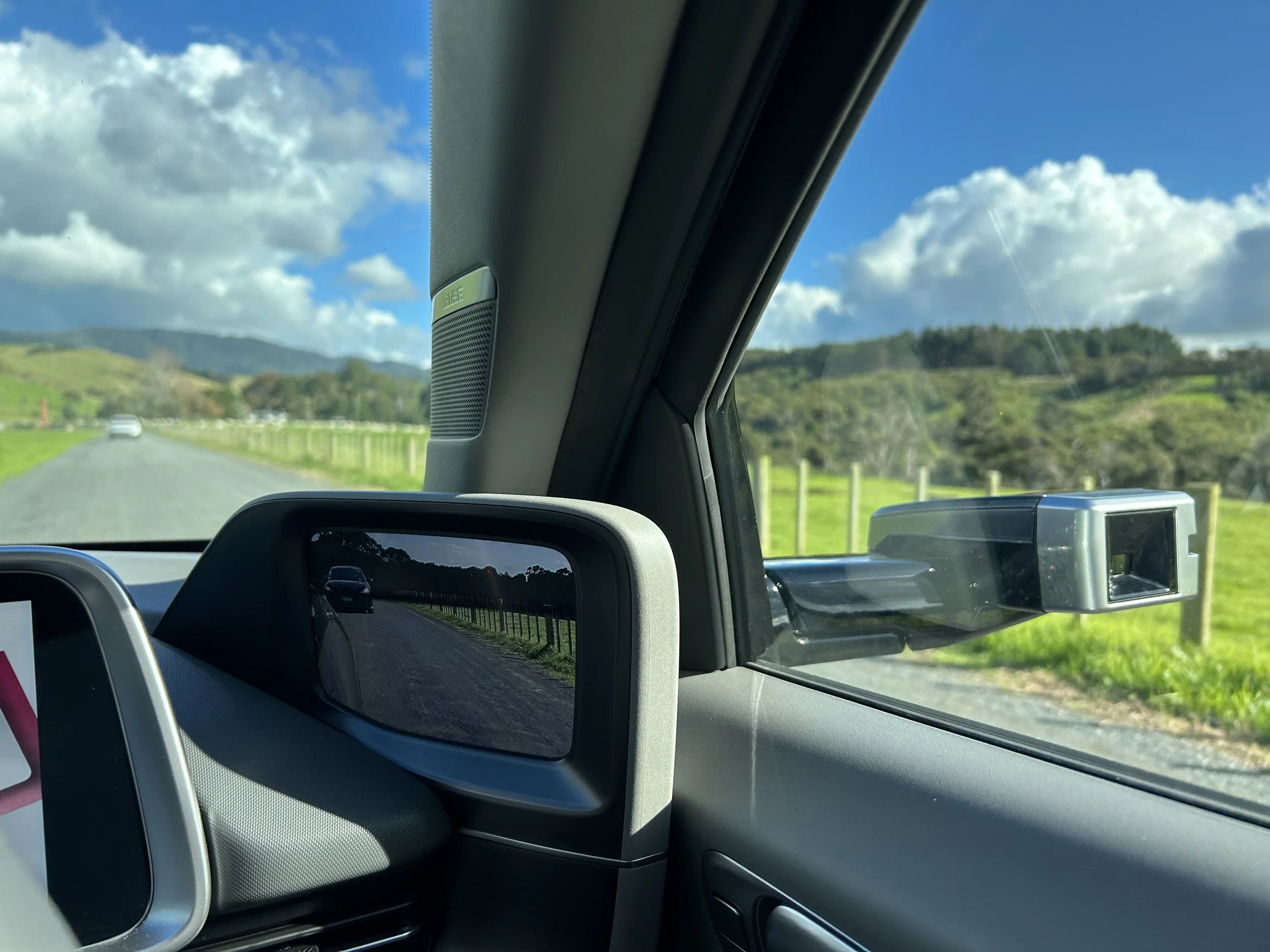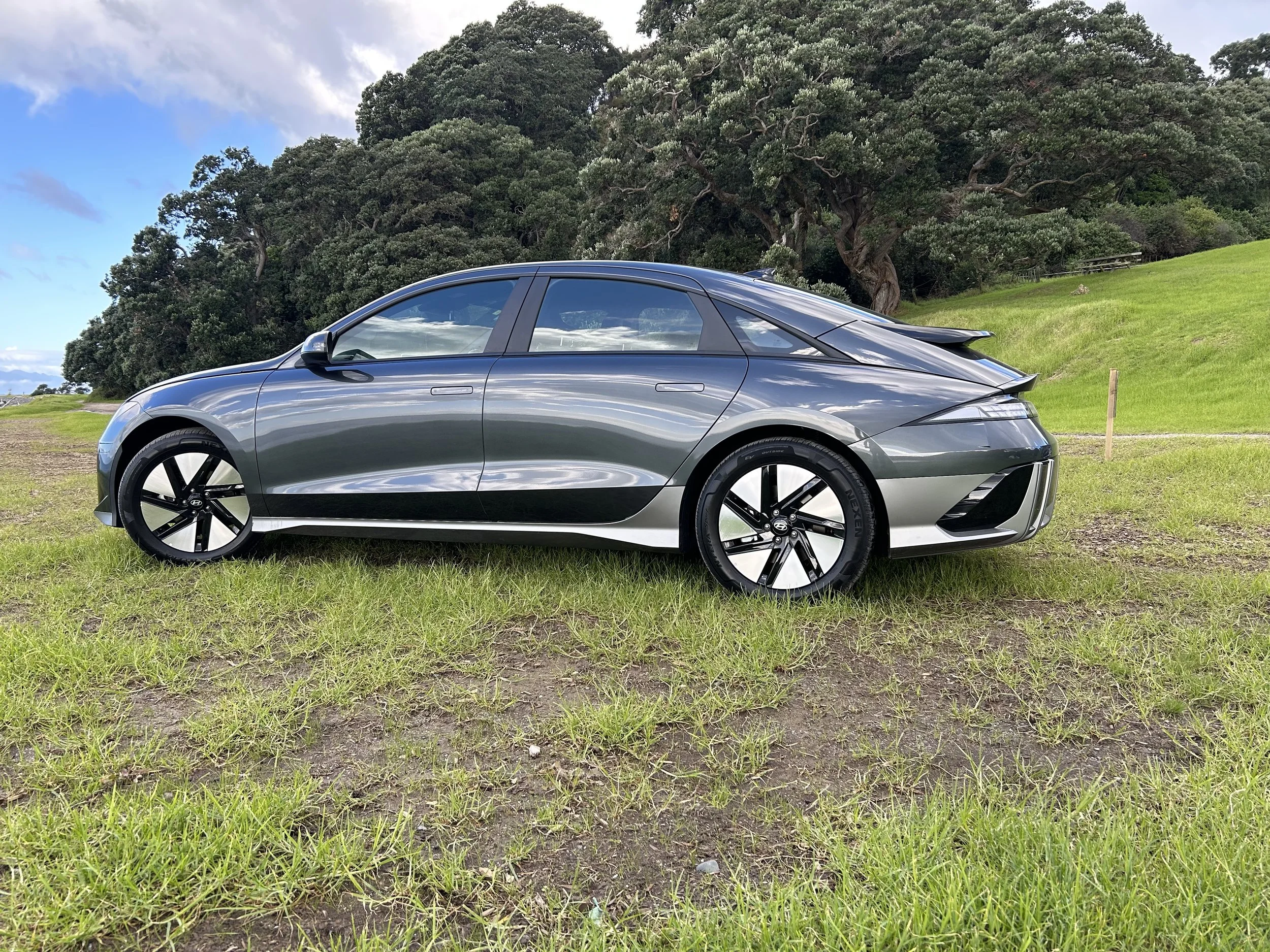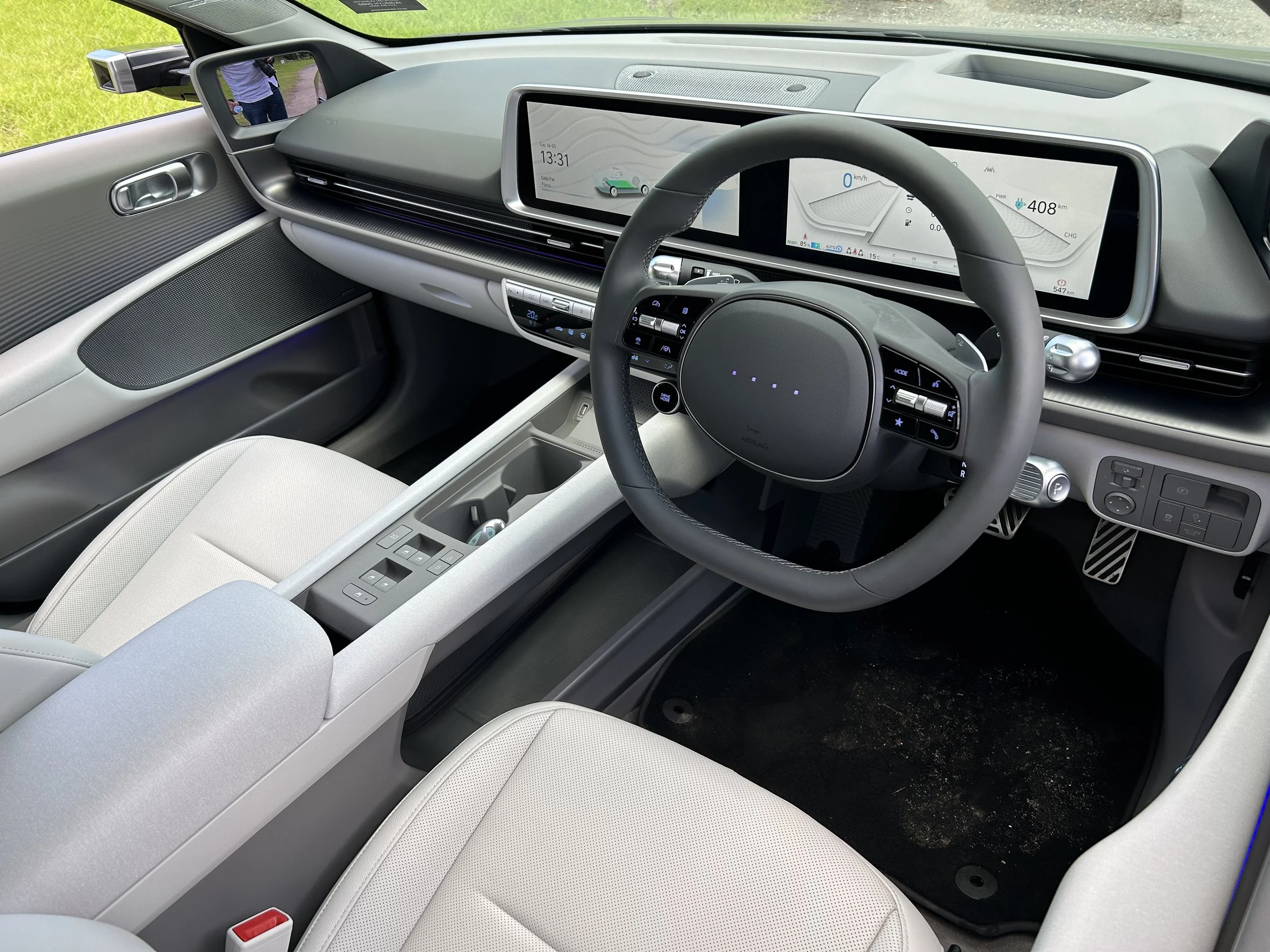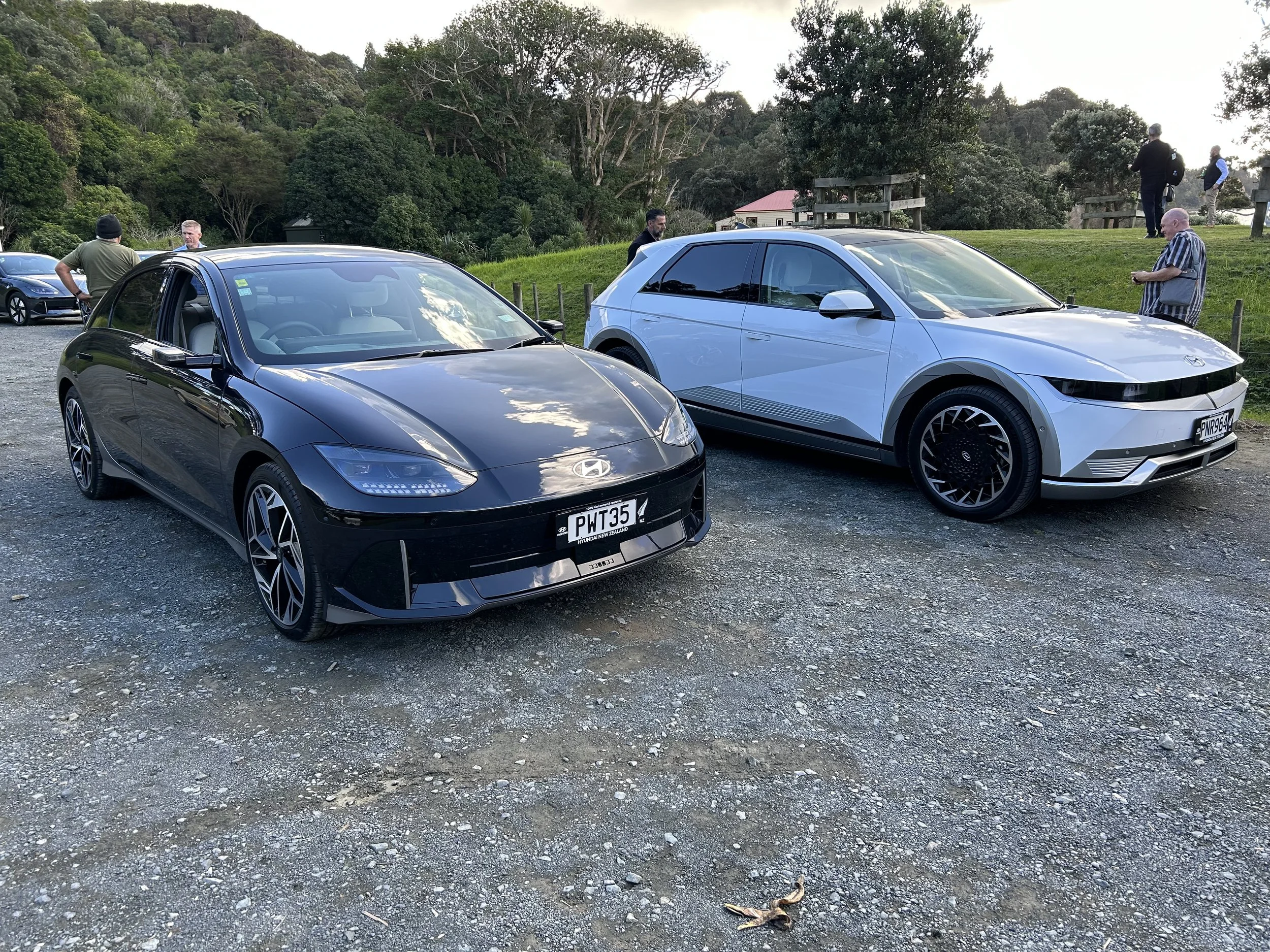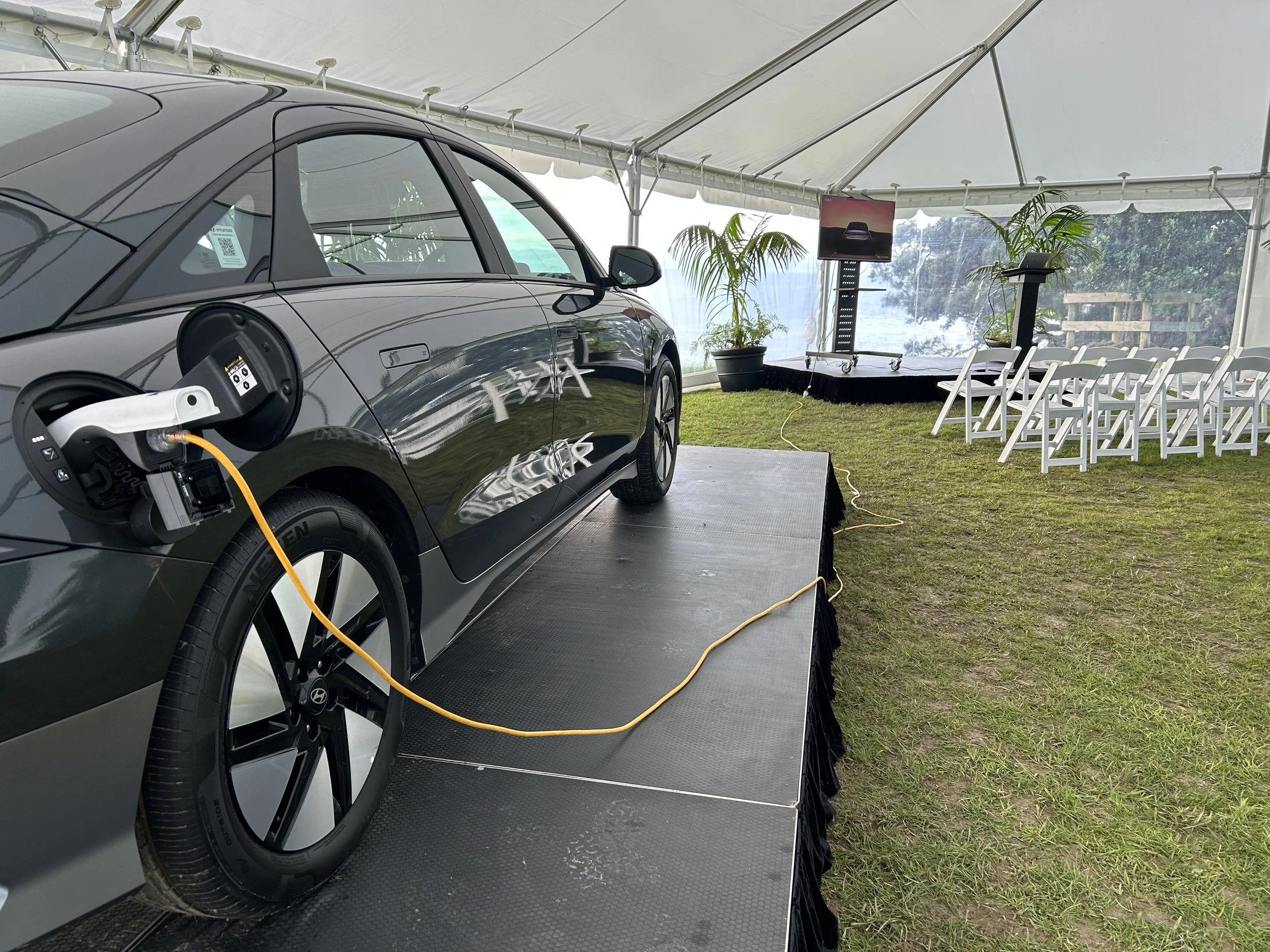Hyundai Ioniq 6 first drive: Latest air style
/Astounding looking electric cars are becoming the norm, but even so ….
A SNIFF of early Saab, a pinch of Porsches’ past, a first-generation Mercedes’ CLS?
Doubtless there will be debate about whether something classic influenced the detailing of the Hyundai’s Ioniq 6 sedan’s rear end. Regardless, let’s agree the car’s pebble-like shape as a whole cannot stand accusation of being derivative, or copycat. Nothing, but nothing, else on the road looks like this.
For all the certainty this new electric sedan is set to be one ‘those’ cars - the kind that really draws a line, with as many people disliking the appearance as there will be those admiring its chutzpah - it cannot be accused of being bland or boring, let alone anonymous.
Whatever you think of the look – and I’m figuring conversations are most likely to trigger when you’re following, due to that riotous rear end - it’d be a disservice to judge by aesthetic alone. A first media drive, out of Auckland yesterday, enforced there's substance behind that radicalism.
A great cabin with a huge level of standard equipment impresses and it is genuinely good to drive, with a definite focus on dynamic decorum. Verification of how well it delivers on promise of remarkable range potential will await another day. Given how well its sister model acquits, the signs are good.
About that familial side. You literally won’t see it when bringing Ioniq 5 and Ioniq 6 together. Regardless the retro-futurist 2021 New Zealand Car of the Year has the same platform, the same cutting-edge (800-volt architecture, ultra-fast charging) tech, at most just door handles seem to share.
Which is better? Styling is subjective and opinions are like arseholes. I love the Six’s detailing, not least that single curve side panel, but am more at ease with the SUV’s blockishness.
Yet there’s a part of me that also suspects that, by being much stronger on the kimchi scale, the sedan possibly will age more resolutely. The world changes so fast. In 2018 the original Ioniq – the one that presented in hybrid, PHEV and full electric – was the best Hyundai could bring. Now it has retired. Given that pace of change, who knows what 2028 will deliver?
Will it sell? Hyundai NZ’s product specialist Ross Wenzlick would be surprised if the ‘Five’ was outpaced this year, but admits that’s not a bet he’d put big money on. The sedan market is nowhere as strong as it once was, but electrics tend to be boundary-breakers. Consider the Tesla Model 3 (which, incidentally, isn’t outright cited as a rival, regardless of being the only other market contender so obviously alike in basic format). Elon’s offer was top selling electric in 2021, a year everything fossil-fuelled with four doors and a boot sunk.
Potentially, then, anything’s possible. At outset, though, the aim is for Ioniq 5 to better last year’s 483 registrations and for Ioniq 6 to do as best it can. With 36 already plated up, it’s off to a good start.
What is clear to Hyundai here, and elsewhere, is that electric will only keep entrenching. Here, Hyundai electrified product – that’s not just fully battery-wed cars, but also plug-in and mild hybrids – already outsell its diesels. As that share increases, the petrol sales percentage falls.
South Korea’s dominant brand, also the world’s third biggest, is ready for that; more Ioniqs beyond the Five-based N, the Ioniq 7 large seven-seater out next year are planned. Chances are every upcoming new car will look more like a concept car for a motor show than a showroom-ready vehicle. Might those include an Ioniq 6 shooting brake?
The sedan isn’t simply Seoul being smart-arsey for the sake of it. Sure, battery and motor packaging allow designs to be so much more daring, but stronger impetus was an old maxim: Less drag, less effort, more range.
Within production car circles, the Ioniq 6 is the zenith. The Prophecy study that previewed the production outcome was prescient; the sedan being almost 22 centimetres longer than the Five, and the roofline 10.5cm lower, is continuation of that ‘streamliner’ study’s utter commitment to aerodynamics.
Even though Hyundai says the car wasn’t an absolute slave to wind tunnel analysis – chief designer Simon Loasby says he also looked to nature, with the peregrine falcon’s hunting shape integrated into the final form – it’s patent data gathered was important.
Drag co-efficiency of 0.21 is really, really low. Most outright sports cars aren’t there. The industry average sits between 0.25 and 0.30. The least slippery Six, by virtue of being on 20-inch rims, is the Limited, and even then it still betters the cubist Five by 23.6 percent. The only other production model locally sold that has potential to join this club is the Mercedes Benz EQE, with a Cd of 0.22.
It’s a shame the specific set-up that reaches the headline-making 600km-plus range is beyond Clean Car rebate reach. Out of the four, just the entry car is eligible for the $8625 now, $7015 from July 1. This $79,990 (yeah, who’d have guessed?) edition packs a 53kWh battery feeding a single motor rear-wheel drive powertrain that, though highly effective – with brand claims of an energy consumption rate of 13.9kWh/100km making it one of the world’s most energy efficient production electric cars – nonetheless gives at best 429 kilometres’ overall range. Which makes it class average.
The headline-hitter, with 614km based on the WLTP test standard, requires a 77.4kWh battery, which comes in three editions. At $94,900 in the same specification as the entry car or a $104,900 Elite and the $124,900 Limited. The last is dual motor, with all-wheel-drive, so trades off range – it’s rated at 545km optimal – for additional oomph.
It makes 239kW/605Nm, whereas the others all have 350Nm but power outputs differ – 111kW in the rebate-winning form and 168kW otherwise. Energy efficiency from the large battery rear-drive is 14.3kWh/100km and 16kWh/100km.
A pre-drive walk around suggests students of design and clever engineering will find no end of fascination. The low, smooth front end has large automatic opening flaps in the lower apron to allow cooling air into the radiator behind, but only when it's needed. There are slots in the outer edges of the bumper as well, to guide air through the wheel wells and reduce drag. Those slim black elements in the bottom part of the arch ahead of the front tyres? Vital ‘Wheel gap reducers’.
The rear’s two different spoiler-like features are massively captivating. Not least the one at the trailing edge of the heavily-sloped rear window, which is Porsche 930 Turbo reminiscent to point imprints on its top edge are like the German car’s cooling slots. Loasby said he would’ve liked to see this as a retractable device, but that was ruled out because of affordability and weight reasons. The second spoiler, above the full-width LED lights, also holds elements of Hyundai's 'Parametric Pixel' motif. They sit above a highly detailed rear bumper/diffuser.
As per the Ioniq 5, flush-fitting door handles are standard. With highest spend, conventional door mirrors are swapped for cameras, their view displayed in high res clarity on panels you can scan while keeping attention on the road. Better than a conventional mirror? Probably not. Whereas the only other make with this tech, Audi, offers it as an option, it’s standard to Limited. You’ll hate to think how much they’ll cost to replace. But a great talking point.
Some of the instruments being a bit futuristic, too. The Limited’s steering wheel has LED lights that flash and colour change for different functions – and signal ‘H’ in morse code on start-up - but overall the cabin is not to space-shippy. There’s no Tesla/Lexus-matching steering wheel alternate of an aircraft-style yoke and, if anything, some defining design elements are understated.
Some interesting plastics and metallic highlights elevate the ambience if you buy above base and there’s impressive mood lighting we unfortunately couldn’t get full benefit from, this being a daytime run. On that subject, the car’s exterior lighting is also a signature, not least when you buy into the LED lamps. The Six accepts over-the-air software updates and, interestingly, Loasby has said some upcoming will be purely for lighting effect.
As in the Ioniq 5, there’s an excellent double-screen layout using two 12.3-inch displays, the one in the middle easy to navigate and sensibly keeping switchgear for the dual-zone climate control below it, along with a physical volume knob and other shortcut buttons for the system.
Unlike in the Five, the centre console doesn't move. It's a two-level design with a rubberised wireless charging pad, USB-A port and cupholders up top and a large storage area underneath with a 12-volt socket. More ports are in the storage box under the armrest and in the back. Interestingly, instead of being on the doors panels as per Ioniq 5, the electric window switches are also on the centre console, allowing Hyundai trim back the door cards and free up more space.
Specification is good at base, naturally a lot richer when you spend more. All models have sat nav and Apple CarPlay and Android Auto – though not wireless, even though there is an inductive charging pad - decent stereos (though only the high-end model has Bose premium, with eight rather than six speakers) and dual zone air con (with a heat pump from Elite upward). Leather is only for the biggest spender, likewise heated and ventilated front and rear seats, and a heated steering wheel.
Hyundai also provisions V2L (Vehicle to Load) function, a feature most electric cars will have within the next few years. A car was used to power up the computer and big television screen for the brand’s presentation, run in a tent at a park. All but the base car get a socket for a normal three-pin plug, allowing you to power everyday devices from your car’s battery.
Hyundai offers an impressive amount of advanced safety technology on its cars as standard, but again only the top level has the full provision with blind-spot warning system, an alert for pedestrians, cars and cyclists that you might be about to crash into, a system to keep you in your motorway lane and rear cross-traffic alert for reversing out into busy roads. A head-up display, surround parking camera and self-parking, now including an angle park ability, also come with the biggest spend.
As much as assists are good, some of what the car lands now is an annoyance. Meeting five-star ANCAP requirement means having a speed warning that reads road signs and will trumpet an electronic alert if you’re a couple of kays over. Six is the first to have this. You can turn it off, but that deactivation lasts only as long as the car is moving. The moment the car restarts, it’s back on guard. This, and a seperate lane keep warning tone, is a tiresome aural intrusion.
Not quite a direct safety thing, but also in the realm is a quirk about the regenerative braking. When running through bends, we noticed the brake lights of the cars ahead were flashing at odd points, usually just after the apex. Was this an over-cautious driver? No, it was the car; when the regen is set high, it enacts hard enough to flash the lamps.
Live with that and enjoy. Despite its low-slung roof, Hyundai calling the cabin a ‘living space’ has credibility. The trick to creating reasonable rear head room is an old one. Hyundai has lowered the seat bench. It’s not a miracle outcome. I’m tall, and it was just made it okay for me. An even lankier colleague found it a touch too snug for headroom but not impossible. I suspect that, if either of us were there for a while, the lessened under-thigh support result from the bench’s placement would irk. Neither of us had to duck too much to get into the back and I found the doors opened wide enough for okay access and egress.
The floor is flat all the way across and the backs of the front seats are scalloped to make plenty of space for knees, as well. There are ISOFIX mountings in the outer two seats.
The rear seatbacks cannot fold down from inside the car, but there are levers in the boot to make that happen. The boot is claimed to offer 401 litres’ capacity, but though it isn’t tall, it does go back a long way. Allow a shopping bag slip too far forward and you might need to find a kid to climb in to retrieve it. As on the Ioniq 5, charging cables and so on can be kept under the bonnet, where there's an extra storage area of 45 litres.
As with Five, the battery pack under the floor means you do step up slightly into the cabin, and hence sit a little higher than in a regular car, but it’s less regal than in the SUV. All round visibility isn’t as good, but there are no major blindspots.
In both, there's a lot of adjustment in the steering wheel and seat, but remarkably for a car so committed to comfort it offers a fully laydown driver’s seat so you can rest up while recharging, only the Limited has fully electric adjust front chairs and on every type the steering column rake-reach adjust is manual. Also, when sub-$60k Peugeot’s have brilliant massage seats, why can’t this Hyundai?
In respect to down time on the cable, there’s merit in zoning in on a 300kW hypercharger, as 10-80 percent replenishment on one of those takes but 25 minutes. The same kind of ‘refill’ on the more common 50kW types is a 73 minute wait. Hooking to an 11kW or a 7kW home charger is an overnighter; seven hours 10 minutes for the first, 11h 45m for the other. A three point plug? Days.
So to driving. I started in the base car and sought to work my way up the range, not quite succeeding as the Elite wasn’t sampled. But still, a good immersion.
Like every electric, it’s dead simple simple to drive. Just push the start button and engage forward or rearward motion. The car defaults to Normal drive mode, but you can press a big button mounted on the steering wheel to choose Eco for maximum range or Sport for maximum responsiveness. You can take advantage of the multiple brake regeneration options, ranging from full one-pedal driving to coasting with no braking resistance.
The different power deliveries between the variants are obvious. None of these editions are slow, but one is much brisker than the other. That’s the Limited.
More than the much-enhanced oomph puts the flagship car well ahead. The dual motor allowing traction from all four wheels makes for tangible change. Above that, the grip from those 20-inch 245/40 Pirelli P-Zeros is something else. It’s not outright sporty, but is certainly invigorating.
What probably also colours this view is that the Limited was experienced for the most challenging part of the drive; a sequence of tight corners in gentle hill country that eventually took us to coastline. It was excellent on that section. Genuinely enjoyable to drive, with good balance and excellent steering feel and afterward I couldn’t help but wonder what extra talent could be revealed were it to fall into the hands of the works hot-rodder, the famous N department. All we know for now is that the Ioniq 5 will be an N next year. Logic suggests a rocketship sedan would be a neat alternate.
This doesn’t mean the rear-drive versions are not also worthy of scrutiny. But they’re different, again; more cruisy in attitude. These models’ 18-inch Nexens, in more modest 225/55 size, are much less performance-oriented. And, of course, you’re dealing with rear-drive. But the drivetrain is more attuned to economy and efficiency. It’s more about being pleasant than punchy.
Whatever the version, one word always springs to mind: 'Refinement'. We sampled a variety of surfaces, gravel included, and it seems exceptionally quiet and smooth; not just in general but more specifically in electric car terms.
The low-drag design helps keep wind roar over the car body and doubtless double-glazed side glass helps as well, but tyre-generated road noise, so often the bane of engineers, seems well-contained, too. The electrics are barely ever audible.
Suspension tune is also a factor. In all but base form, Ioniq 5 has seemed a touch brittle. It’s the one area in which the Kia EV6 shows it up. Hyundai’s sub brand says that’s because it employed in-house specialists in Australia to refine the tune for this part of the world. The end result means the EV6 rides better than the Five.
But now I’m thinking Kia’s crowing outcome didn’t go down well back in the big house in Seoul. Though Kia is denied the sedan, it could be that the parent wanted to prove a point about who really calls the shots. Whatever, on strength of several hundred kays’ driving, I’m pretty certain the Six has brought the advantage back to the parent make. It’s not Citroen-esque in smoothness, because it can still evidence bump-thump over imperfections, but overall it has redressed.
In all forms, it delivers a great compromise between comfort and control. It also feels a bit more agile and a touch lighter on its feet in any form than any comparable Ioniq 5; it also has nicer steering feel.
Energy consumption was not given too much regard, as the duration of driving was but for a few hours, but clearly as with all electrics – well, all cars – the harder you go, the harder it hits the fuel. Energy consumption in the Limited, all we drove for the afternoon leg, was at its highest, around 19-20kWh/100km in the hills, but when heading back up the Auckland motorway it fell to around 14kWh/100km.
When the Five arrived, it seemed something special. It ticked most boxes and looked like nothing else on the road. The Six is all the more interesting because it is even more astounding in appearance – to point of controversy, perhaps - and has better driving manners. On the other hand, though the cabin is spacious, it nonetheless has a much smaller boot than the Five and is, overall, a much less practical car.
As with its sibling the big challenge is the pricing. Hyundai builds all sorts of cars, but these E-GMP electrics seem to be set to site primarily as premium choices.
Everything about how they construct is expensive; more than just the battery. It’s possible even the usual nod to planet-saving through use of friendly recycled materials (carpets from fishing nets, natural oils to treat the leather, black pigment made from upcycled tyres for the polycarbonate black car parts), adds to cost.
The technology is undeniably leading edge. Teslarati might think the Model 3 is the epitome, but in reality the Hyundai is a more advanced car in areas where it matters most – even with simple driver convenience stuff. This platform being among a handful sorted for 800 volt capacity is a big thing. That’s as advanced as it gets in our market.
But no E-GMP product has been cheap and the Six is particularly top dollar, entering with a premium over others here on this underpinning, Kia product included. The base car’s rebate positioning is salutary, but the step ups from there are sobering. The Limited sites only $7000 below an entry EQS.
The writer attended this event as a guest of the distributor, with travel, meals and a modest gift provided.



